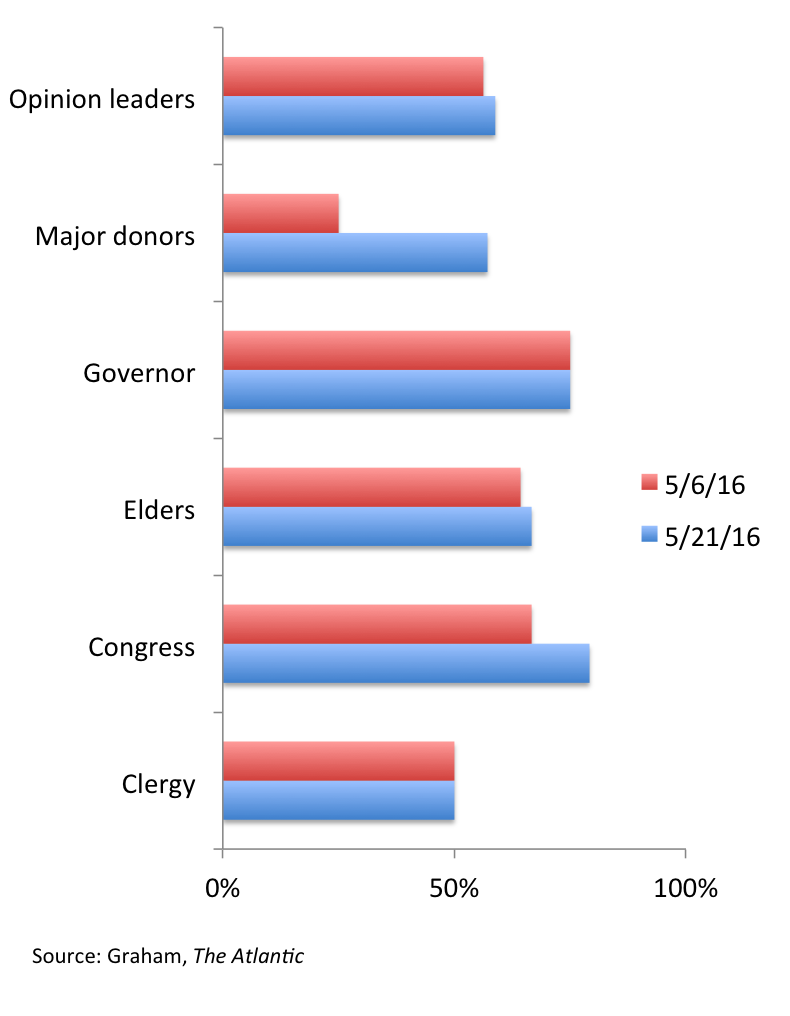After a contentious primary season, the big names in the Republican Party are starting to rally behind Donald Trump.
By Seth Masket
Donald Trump flashes the thumbs-up as he arrives on stage for the start of the Republican presidential debate on August 6, 2015, at the Quicken Loans Arena in Cleveland, Ohio. (Photo: Mandel Ngan/AFP/Getty Images)
When Donald Trump became the presumptive Republican nominee a few weeks ago, one of the interesting stories was how few Republican leaders were actually on board with him. Over the past two weeks, however, we’ve seen an unmistakable shift — the party is falling in line.
I wrote a post a few weeks ago, based on David Graham’s reporting at The Atlantic, looking at the differences between those Republican elites who had come out in favor of Trump and those who were holding back their support. I noted that an important difference was the re-election incentive — senators facing re-election this year, for example, seemed much more likely to be backing Trump than those not up for re-election.
Fortunately, Graham has continued to update his collection, and a trend is quite obvious. The chart below shows the percent of party elites in each category endorsing Trump. As the chart shows, Trump’s support has improved in nearly every category, and it certainly hasn’t gone down in any.

Percent of Republican Party elites endorsing Donald Trump.
Notably, these shifts haven’t really occurred due to position-switching. Very few elites have gone from opposing Trump to backing him in the past few weeks. House Republican Caucus Chair Cathy McMorris Rodgers (Washington) and Senator Susan Collins (Maine) have recently switched to supporting him, but beyond that, the changes have come from other elites announcing their support for Trump. People who hadn’t made any declaration of support at all are coming out of the woodwork to back Trump. This includes such prominent names as House Majority Leader Kevin McCarthy (California) and House Majority Whip Steve Scalise (Louisiana).
All of this helps explain why Republican voters have come to rally behind Trump. A recent poll found that Hillary Clinton leads Trump 78–9 among Democrats, while Trump leads Clinton 78–7 among Republicans. In other words, Republican voters appear just as unified as Democratic voters do.
But why are Republican leaders falling in line behind Trump? Many of these, after all, are people who raised strong concerns about him just a few months ago, and quite a few of these people were directly insulted by Trump in the primary season.
They’re backing Trump for the same reason they failed to stop him from winning the nomination. Basically, because they’ve been unable to coordinate. If you’re a Republican thinking about your political future, even if you don’t like Trump and think he’s bad for your party and your country, you don’t want to be the one person flipping the bird to half your party’s primary voters. Those voters are active and paying attention, and they could turn on you. If a substantial percentage of party elites were doing that along with you, it might suggest that you’re part of a serious opposition movement, and that you’re willing to sacrifice an occasional election in order to protect conservative principles. But party elites were unable to pull off this kind of coordination back when Trump was just a joke candidate last year — why should they be able to pull it off now?
Besides, Republican elites well understand that Trump, like him or not, is their standard-bearer for the fall. No doubt some Republican congressional, gubernatorial, and state legislative candidates will seek to distance themselves from him at some point this fall, but it will do little good. Their fortunes will largely rise and fall with Trump’s. And the most they can do for their own futures is to give him as bright a one as possible.

||





